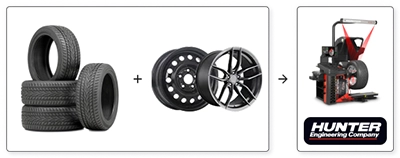Understanding Tire Tread Patterns: How to Mount, Balance, and Install Different Tire Types at Home or by a Mechanic

The winter season is just around the corner, and it's almost time for most Canadians to switch from their summer or all-season tires to winter tires. Understanding tire tread patterns is crucial for installing your tires on your vehicle to make sure they offer maximum performance and safety whether the installation is made at home or by a mechanic. The correct installation of tires on a vehicle involves two primary considerations:
-
Mounting the Tires on the Wheels: Typically done by a professional mechanic to ensure proper fit and balance.
-
Installing the Tire and Wheel Assembly on the Vehicle: Often performed by mechanics but it’s not rare to see vehicle owners doing it at home. You can see the list of the required equipment to perform your tire change or rotation at home at the end of this article.
Types of Tire Tread Patterns
Directional Tread Pattern
Directional tires are designed with a distinct “V-shaped” tread pattern and have a rotational arrow on the sidewall indicating the direction the tire should roll. This ensures optimal performance and safety.
Installation
Mounting and balancing
- The mechanic must mount two tires for the right-hand side and two for the left-hand side of the vehicle, ensuring all arrows point towards the front of the vehicle once installed on the vehicle.
Installation on the vehicle
- When installing the tires, it’s vital to follow the directional arrows to maintain proper tire performance.

Advantages
- Superior snow evacuation, providing better traction in snowy conditions.
- Enhanced hydroplaning resistance due to the efficient water evacuation design.
Disadvantages
- Limited to one side of the vehicle; the installer must correctly position two tires for the right and two for the left side.
- Typically noisier than asymmetrical tires.
- Rotation is restricted to front-to-back unless tires are unmounted and remounted, which is labour-intensive and can incur additional costs.
- Staggered setups (wider tires on the rear axle) cannot be rotated at all without remounting, increasing the risk of premature wear.
Asymmetrical Tread Pattern
Asymmetrical tires feature different tread patterns on the inside and outside shoulders. They are marked with “Outside” and “Inside” on the sidewalls to guide proper mounting.
Installation
Mounting and balancing
- Ensure the tires are mounted with the “Outside” marking on the outer shoulder.
Installation on the vehicle
- Once mounted on wheels, these tires can be installed on either side of the vehicle without concern for directional alignment.

Advantages
- Optimized performance for cornering and handling, making them ideal for sports and performance vehicles.
- Can be installed on any side of the vehicle once mounted.
- Flexible rotation options, including front-to-back and side-to-side, enhancing tire lifespan.
- Generally quieter than directional tires.
Disadvantages
- Typically offer less snow traction and evacuation compared to directional tires.
Symmetrical Tread Pattern
Symmetrical tires have a uniform tread pattern without a specific direction, and their shoulders are often mirror images of each other.
Installation
Mounting and balancing
Can be installed in any orientation.
Installation on the vehicle
No specific alignment required; tires can be rotated in any direction (front-to-back, side-to-side) without issues, just like asymmetrical tires.

Advantages
- Simplified installation and rotation since orientation does not affect performance.
- Can be installed on either side of the vehicle without concern for directional or asymmetrical constraints.
Disadvantages
- Typically offer lower performance in snow evacuation.
- Less optimized for cornering and handling compared to asymmetrical tires.
PMCtire's Professional Tire Mounting Service
At PMCtire, when customers order a set of wheels and tires to be mounted and balanced, our professionals take meticulous care to analyze the type of tire ordered. We ensure they are mounted and balanced correctly so that the mechanic or customer at home can install them on the vehicle without worrying about the mounting process. This attention to detail guarantees optimal performance and safety from the moment the tires hit the road.
What You Need for a Tire Change or Rotation at Home
Changing or rotating your tires at home can be a straightforward process if you have the right tools and equipment. Here’s a list of items you'll need to get the job done efficiently and safely:
-
Jack: A sturdy car jack is essential for lifting your vehicle off the ground. Make sure it is rated for the weight of your vehicle.
-
Jack Stands: These provide additional support and stability while the car is lifted. Never rely solely on the jack to hold up your vehicle.
-
Wheel Chocks: These prevent the car from rolling while it’s jacked up. Place them behind the wheels that remain on the ground.
-
Lug Wrench: A lug wrench (or tire iron) is used to remove and tighten the lug nuts on your wheels. A torque wrench is also recommended to ensure the lug nuts are tightened to the manufacturer's specifications.
-
Impact Gun: Although not required, an impact gun will help speed up the process of untightening the lug nuts a lot compared to doing it with the wrench only
-
Socket Set: This will include various socket sizes to fit different lug nuts.
-
Gloves: Protect your hands with a good pair of work gloves.
-
Tire Pressure Gauge: Ensuring your tires are inflated to the correct pressure is crucial for safety and performance.
-
Torque Wrench: This ensures that lug nuts are tightened to the proper torque specification, which is vital for wheel safety.
Having these tools on hand will help you perform tire changes or rotations safely and efficiently at home. Always refer to your vehicle’s owner manual for specific instructions and safety guidelines related to tire maintenance.
Understanding the differences between directional, asymmetrical, and symmetrical tread patterns can help you choose the right tires for your vehicle and driving needs. Whether prioritizing snow traction, cornering performance, or ease of installation and rotation, selecting the appropriate tire tread pattern is essential for maximizing safety and performance.
For professional advice and installation services, do not hesitate to reach out to our tire experts who will answer any questions you might have regrding the best tire options that suit your needs!
Dominic Vaillancourt
Automotive expert & Spokesperson


